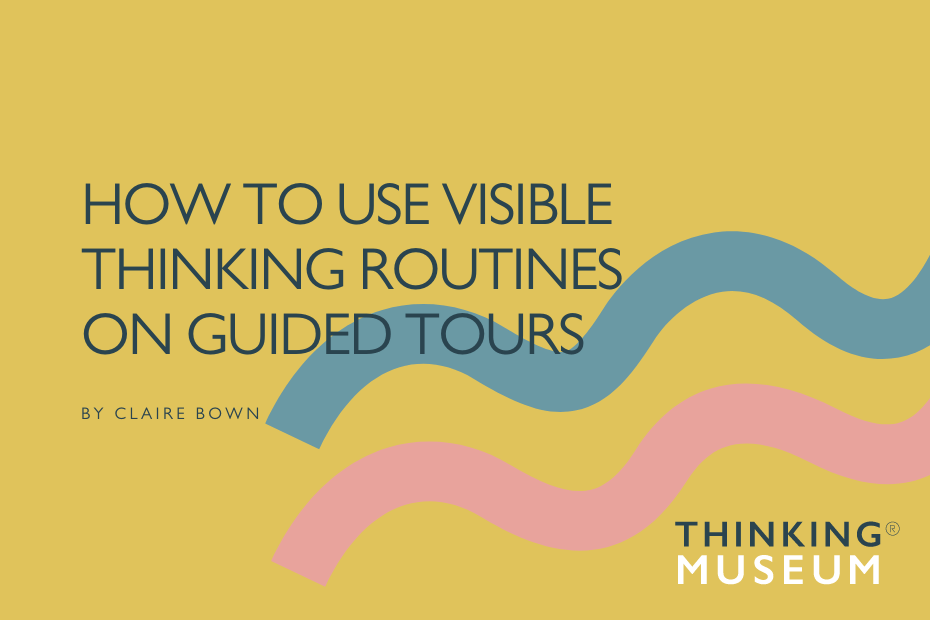Routines are an important part of the guided tour experience. As you welcome guests or visitors at the start of a tour, you will take a few minutes to remind visitors of any guidelines to keep visitors and any historic sites or collections safe. You will also introduce them to the theme and structure of the tour. If done well, these guidelines help participants to understand what to expect and what to do.
Imagine the benefits then of a routine that would help visitors to make sense of objects/artworks/buildings in a memorable and engaging way? Imagine what would happen if (museum) guides used such routines to facilitate open-ended discussions with groups?
Questioning strategies, routines or procedures have been in use for some time now in museum education. Museum educators guide people through the exploration of an artwork/object by asking questions aimed at stimulating thought processes and encouraging visitors to take a more active role in thinking and reasoning. These methods weigh heavily on the ability of the museum guide to be a good facilitator: using an open style of questioning and working to ensure that all participants feel happy to take part and to feel valued and understood.
Thinking Routines as questioning frameworks
The thinking routines developed as part of the Visible Thinking framework are a good example of a questioning framework that works well, is easy to remember and produces great responses.
Thinking routines, developed by researchers at Harvard’s Project Zero, are tools specifically designed to help, support and guide mental processes or thinking. They consist of short, easy to learn and teach steps that get used in a regular fashion. Visible Thinking Routines are short, easy to use and are composed of a few simple steps.
For example, See Think Wonder:
- What do you see?
- What do you think about what you see?
- What does it make you wonder?
See Think Wonder was developed as part of the Artful Thinking & Visible Thinking projects at Project Zero, Harvard Graduate School of Education.
This routine concentrates on the importance of observation, interpretation and stimulating curiosity. It is an excellent inquiry framework to use at the beginning of a museum programme. The stages of the routine structure the conversation for both the museum educator and for the participants. As a result, everyone knows what to expect.
Key Benefits
- Factual or supplemental information can be added as and when required. Questining frameworks, such as thinking routines, allow information to be offered to the group in small amounts and at appropriate times, rather than as a lecture by the guide.
- Any framework or protocol can also be adapted or modified to suit the needs of the group or educators can even create their own.
- A selection of different frameworks can be used throughout a programme to target different areas of thinking and keep the programme lively.
- Provide a loose, flexible structure around which to base the discussion of an artwork or object. This flexible structure organises thoughts and serves as the backbone for the discussion and helps museum guides (and visitors) to know what to expect. It helps the discussion become a rounded whole rather than a loose muddle of open-ended questions. The key point is that any framework should be memorable enough for you to easily recall where you are in the discussion.
- The questions of the framework are carefully worded to allow for multiple interpretations and to open up discussions. The wording of the questions in the routines also helps guides or educators format their own open-ended questions.
- You can use questioning frameworks such as thinking routines on all types of guided programmes and experiences – in all types of museums, historic houses, outdoor walking tours, food tours and so on.
Questioning frameworks are more than just a strategy; they provide a structure for making meaning and give participants – young or old – a chance to participate and interact in the guided experience. Choose frameworks that help you to explore ideas, spark curiosity and provoke debates in a variety of contexts and environments.
Further Reading: Ritchhart, R. 2007. ‘Cultivating a Culture of Thinking in Museums.’ Journal of Museum Education, 32(2), pp.137-154 and Bown, C. 2015. ‘Visible Thinking and Interpretation’ in Interpreting the Art Museum, Ed. Graeme Farnell
Sign up for my Curated newsletter
Every other Friday I share a small dose of curated inspiration. It might be things I’ve read, things I’ve listened to or things I’ve watched.
Hear about my latest podcast episode and read useful tips, recommendations and things that I love. Join via the button below.

Pingback: Establishing Decent Docent Skills is Routine | thinking museum
Pingback: Information Overload: How much is too much? | thinking museum
Pingback: Stuck in a Tour Rut? 6 Tips to Refresh your Guided Tours
Pingback: 11 quick ways to improve your questioning technique
Pingback: How to Make your Art Discussions Engaging On Zoom (Part 2)